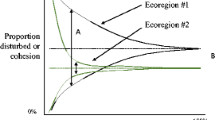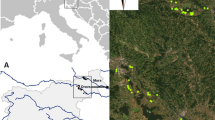Abstract
Increasingly forest land is diverted to different land uses leading to various levels of disturbances in a landscape. Any disturbance could affect the structure and functions of a landscape, their inherent properties and interactions, thereby could lead to temporal or irreversible changes. In this chapter, the spatial distribution of various forests and non-forest patches were combined with road and settlement proximity zones using remote sensing and GIS tools to generate disturbance index (DI) of a landscape, by adopting landscape ecological principles. Various landscape ecological matrices such as forest fragmentation, interspersion, juxtaposition patchiness, and porosity, were analyzed using spatial analysis. Field sampling data on species richness from 862 plots (nested quadrats of 20 × 20 m2) were analyzed to adjudge the correlation between different DI levels and their diversity content, and interestingly, higher species richness was observed for lower DI levels. The study was selected is the northeastern India of the eastern Himalaya accommodating Arunachal Pradesh, Assam, and Meghalaya states. DI demonstrated progressive disturbance in the forest structure and composition. Meghalaya state has better reflected the decreasing pattern of DI with species richness and its endemic subset. Disturbance Index, a landscape-based model proved to have well captured the patterns and processes, thereby advocating wider application and replication for conservation planning.
Access this chapter
Tax calculation will be finalised at checkout
Purchases are for personal use only
Similar content being viewed by others
References
Barik SK, Behera MD (2020) Studies on ecosystem function and dynamics in Indian sub-continent and emerging applications of Satellite remote sensing technique. Tropical Ecol 61(1):1–4
Behera MD, Kushwaha SPS (2007) An analysis of altitudinal behavior of tree species in Subansiri district. Eastern Himalaya, Biodivers Conserv 16:1851–1865
Behera MD, Jeganathan C, Srivastava S, Kushwaha SPS, Roy PS (2000) Utility of GPS in classification accuracy assessment. Current Sci 79(12):1996–1700
Behera MD, Kushwaha SPS, Roy PS, Srivastava S, Singh TP, Dubey RC (2002) Comparing structure and composition of coniferous forests in Subansiri district, Arunachal Pradesh. Current Sci 82(1):70–76
Behera MD, Kushwaha SPS, Roy PS (2005) Geo-spatial modeling for rapid biodiversity assessment in Eastern Himalayan region. For Ecol Manag 207:363–384
Behera MD, Tripathi P, Das P, Srivastava SK, Roy PS, Joshi C, Behera PR, Deka J, Kumar P, Khan ML, Tripathi OP, Dash T, Krishnamurthy YVN (2018) Remote sensing based deforestation analysis in Mahanadi and Brahmaputra river basin in India since 1985. J Environ Manage 206:1192–1203. https://doi.org/10.1016/j.jenvman.2017.10.015
Champion HG, Seth SK (1968) A revised survey of forest types of India, Manager of Publications, Government of India, New Delhi
Chitale VS, Behera MD, Roy PS (2020) Congruence of endemism among four global biodiversity hotspots in India. Curr Sci 118(1):9
Das P, Behera MD, Pal S, Chowdary VM, Behera PR, Singh TP (2020) Studying land use dynamics using decadal satellite images and Dyna-CLUE model in the Mahanadi river basin, India. Environ Monit Assess 191(3):804. https://doi.org/10.1007/s10661-019-7698-3
Das P, Mudi S, Behera MD*, Barik SK, Mishra DR, Roy PS (2021) Automated mapping for long-term analysis of shifting cultivation in Northeast India. Remote Sens 13(6):1066
Das P, Behera MD, Patidar N, Sahoo B, Tripathi P, Behera PR, Srivastava SK, Roy PS, Thakur P, Agrawal SP (Oct 2017) “Changes in evapotranspiration, runoff and baseflow with LULC change in eastern Indian river basins during 1985–2005 using variable infiltration capacity approach”. 38th Asian conference on remote sensing—space applications: touching human lives, ACRS 2017
Dillworth ME, Whistler JL, Merchant JW (1994) Measuring landscape structure using geographic and geometric windows. Photogram Eng Remote Sens 60:1215–1224
Forman R, Godron M (1986) Landscape Ecology. John Wiley & Sons, New York
Heywood VH, Watson RT (1995) Global biodiversity assessment. Cambridge University Press, New York
Kaul RN, Haridasan K (1987) Forest types of Arunachal Pradesh – A preliminary study. J Econ Taxonomic Bot 9:379–389
Khan ML, Menon S, Bawa KS (1997) Effectiveness of protective area network in biodiversity conservation: a vase study of Meghalaya state. Biodiver Conserv 6:853–868
Li X, Gong P, Liang L (2015) A 30-year (1984–2013) record of annual urban dynamics of Beijing city derived from landsat data. Remote Sens Environ 166:78–90. https://doi.org/10.1016/j.rse.2015.06.007
Lidicker WZ (1995) Landscape approaches in mammalian ecology and conservation, University of Minnesota Press, Minneapolis, Minnesota
Lyon JG (1983) Landsat derived landcover classifications for locating potential nesting habitat. Photogrammetric Eng Remote Sens 49(2):245–250
Mahanand S, Behera MD, Roy PS, Kumar P, Barik SK, Srivastava PK (2021) Satellite based fraction of absorbed photosynthetically active radiation is congruent with plant diversity in India. Remote Sens 13(2):159
Moloney KA, Levin SA (1996) The effects of disturbance architecture on landscape-level population dynamics. Ecology 77:375–394
Monmonier MS (1974) Measure of pattern complexity for chor opleth maps. American Cartographer 1(2):159–169
Murthy MSR, Das P, Behera MD (2016) Road accessibility, population proximity and temperature increase are major drivers of forest cover change in Hindu Kush Himalayan region: study using Geo-Informatics approach. Curr Sci 111(7):1599–1602
Myers N (1988) Threatened biotas: ‘hotspots’ in tropical forestry. Environmentalist 8:1–20
Pandey SK, Shukla RP (1999) Plant diversity and community patterns along the disturbance gradient in plantation forests of sal (Shorea robusta Garten.). Curr Sci 77(6):814–818
Pasha SV, Behera MD, Mahawar SK, Barik SK, Joshi SR (2020) Assessment of shifting cultivation fallows in Northeastern India using Landsat imageries. Tropical Ecol 61(1):65–75
Patidar N, Keshari AK (2020) A rule-based spectral unmixing algorithm for extracting annual time series of sub-pixel impervious surface fraction. Int J Remote Sens 41(10):3970–3992. https://doi.org/10.1080/01431161.2019.1711243
Pickett STA, Thompson JN (1978) Patch dynamics and the design of nature reserves. Biol Conserv 13:27–37
Pickett STA, White PS (1985) The ecology of natural disturbance and patch dynamics. Academic Press, London
Romme W, Knight DH (1982) Landscape diversity: the concept applied to Yellowstone National Park. Bioscience 32:664–670
Roy PS, Tomar S (2000) Biodiversity characterization at land scape level using geospatial modelling technique. Biol Conser 95:95–109
Roy PS, Behera MD (2005) Rapid assessment of biological richness in a part of Eastern Himalaya: an integrated three-tier approach. Current Sci 88(2):250–257
Roy PS, Kushwaha SPS, Murthy MSR, Roy A, Kushwaha D, Reddy CS, Behera MD, Mathur VB, Padalia H, Saran S, Singh S, Jha CS, Porwal MC (eds) (2012) Biodiversity characterisation at landscape level: national assessment, Indian Institute of Remote Sensing, Dehradun, India, pp 140, ISBN 81-901418-8-0
Roy PS, Roy A, Joshi PK, Kale MP, Srivastava VK, Srivastava SK, Dwevidi RS, Joshi C, Behera MD, Meiyappan P, Sharma Y, Jain AK, Singh JS, Palchowdhuri Y, Ramachandran RM, Pinjarla B, Chakravarthi V, Babu N, Gowsalya MS, Kushwaha D (2015) Development of decadal (1985–1995–2005) land use and land cover database for India. Remote Sens 7(3):2401–2430. https://doi.org/10.3390/rs70302401
The State of India Forest Report (2019) Forest Survey of India, DehraDun
Turner MG (1989) Landscape ecology: the effect of pattern on process. Ann Rev Ecol Syst 20:171–197
Turner MG, Gardener RH, Dale VH, O’Neill RV (1993) A revised concept of landscape equilibrium: disturbance and stability on scaled landscapes. Landsc Ecol 8(2):13–227
Wagner PD, Kumar S, Schneider K (2013) An assessment of land use change impacts on the water resources of the Mula and Mutha rivers catchment upstream of Pune, India. Hydrol Earth Syst Sci 17:2233–2246. https://doi.org/10.5194/hess-17-2233-2013
Acknowledgments
The Author thanks authorities of Spatial Analysis and Modelling (SAM) Laboratory, Centre for Oceans, Rivers, Atmosphere and Land Sciences (CORAL) at Indian Institute of Technology Kharagpur for providing facilities for preparation of the chapter.
Author information
Authors and Affiliations
Corresponding author
Editor information
Editors and Affiliations
Rights and permissions
Copyright information
© 2022 The Author(s), under exclusive license to Springer Nature Switzerland AG
About this chapter
Cite this chapter
Behera, M.D. (2022). Modeling Landscape Level Forest Disturbance-Conservation Implications. In: Pandey, A., Chowdary, V.M., Behera, M.D., Singh, V.P. (eds) Geospatial Technologies for Land and Water Resources Management. Water Science and Technology Library, vol 103. Springer, Cham. https://doi.org/10.1007/978-3-030-90479-1_5
Download citation
DOI: https://doi.org/10.1007/978-3-030-90479-1_5
Published:
Publisher Name: Springer, Cham
Print ISBN: 978-3-030-90478-4
Online ISBN: 978-3-030-90479-1
eBook Packages: Earth and Environmental ScienceEarth and Environmental Science (R0)




